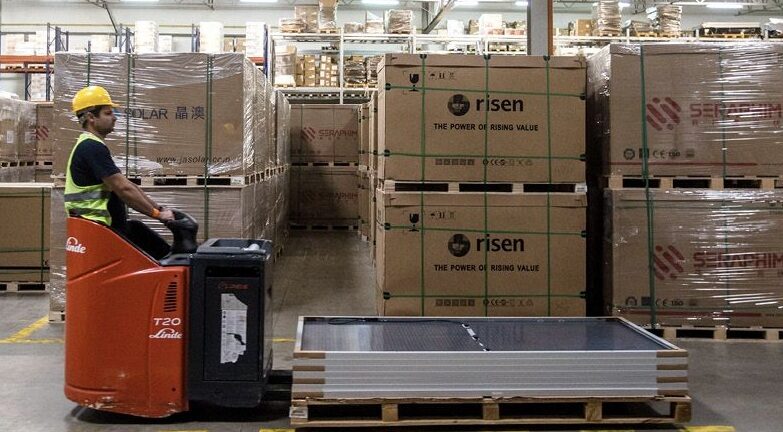An international research team has investigated the impact of wind-induced vibrations on solar modules and has found that wind-induced stress can have significant mechanical repercussions on PV arrays, especially for those with large-size panels.
“First torsional frequencies of the tracker system lying in the range of 4 Hz to 5 Hz were observed due to twisting and torsion using modal analysis,” the research's lead author, Sagarika Kumar, told pv magazine. “Such type of movements could lead to microcracks, more serious mechanical failures, misalignments, and ultimately to the system collapse.”
“The existing PV module certification scheme may not fully address the impact of these new environmental challenges for large-area modules, leaving significant gaps,” Kumar added. “Our research aims to address these gaps.”
The scientists proposed an action plan structured into two collaborative phases, designed to build a robust understanding of wind-induced effects on PV systems. The first phase focused on PV system analysis, including modal analysis, simulations of static and dynamic loading under varying wind conditions, and flow-induced vibration modeling. The second phase centered on wind-fluid-based analysis, incorporating historical wind data interpretation, computational fluid dynamics (CFD) modeling, and wind tunnel testing of scale models.
“To complement these efforts, we aim to explore the effects of novel mechanical stress conditions on PV modules through targeted laboratory experiments,” the scientists said. “This collaborative and iterative approach helps refine testing parameters for accelerated indoor vibration and loading tests. Ultimately, the findings will contribute to developing recommendations for wind-induced failure testing, with the potential for adoption by the International Electrotechnical Commission (IEC).”
The team also ran a structural load analysis to assess static wind pressure corresponding to varying wind speeds. It assumed a northerly wind measured at 10 m/s corresponding to a Category 1 hurricane and a wind velocity at the tracker height level of around 33 m/s. This analysis showed that inducing static loading on the module's rear side can result in a displacement of about 5.1 cm.
“The current IEC 61215-2 tests include a static and a dynamic mechanical load test,” Kumar emphasized. “However, they do not sufficiently represent the mechanical stress observed, hence, we are currently investigating asymmetric and torsional loading conditions as the next step.”
In order to better represent the real-world scenarios investigated in their work, the academics proposed a protocol including mid-frequency vibration testing and dynamic load testing with non-uniform load distribution.
The vibration test frequency is conducted for 8 hours in accordance with IEC 60068-1 and 60068-2-6 standards. During the test, the module undergoes “horse-galloping motion” at frequencies from 3.5 Hz in an environmental chamber. The module is mounted with a 60% overhang to simulate worst-case mounting configurations. Considering combined environmental stresses, the protocols integrate temperature and humidity impacts.
Furthermore, the vibration test includes thermal cycling to simulate thermomechanical fatigue, running for 9 cycles, followed by vibration testing for up to 8 hours. “However, this testing protocol is still in investigation phase and may require further development,” Kumar said.
The dynamic load testing evaluates the effect of torsional galloping on the module using a two-corner clamping method with up to 1000 Pa pressure loads. This load is twice that of simulated results, to simulate a Category-1 hurricane in an accelerated framework. The cycles are set to 1,000, based on IEC 61215:2021.
“While current testing protocols provide a foundation, they may be missing the nuanced conditions presented by extreme weather events,” she added. “Our research attempts to advance this foundation by introducing mid-frequency vibration and dynamic load tests specifically designed for wind-induced stresses, including asymmetric and torsional loading conditions.”
The research team included scientists from the Renewable and Sustainable Energy Research Centre of Technology Innovation Institute in Abu Dhabi, UAE, and the Solar Energy Research Institute of Singapore (SERIS). Its findings were published in the paper “Testing of Wind-induced Vibrations on Solar Photovoltaic Modules.”
This content is protected by copyright and may not be reused. If you want to cooperate with us and would like to reuse some of our content, please contact: editors@pv-magazine.com.




By submitting this form you agree to pv magazine using your data for the purposes of publishing your comment.
Your personal data will only be disclosed or otherwise transmitted to third parties for the purposes of spam filtering or if this is necessary for technical maintenance of the website. Any other transfer to third parties will not take place unless this is justified on the basis of applicable data protection regulations or if pv magazine is legally obliged to do so.
You may revoke this consent at any time with effect for the future, in which case your personal data will be deleted immediately. Otherwise, your data will be deleted if pv magazine has processed your request or the purpose of data storage is fulfilled.
Further information on data privacy can be found in our Data Protection Policy.